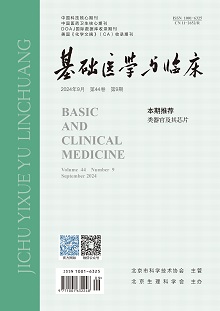Effect of artesunate on neuroinflammation in depressed mouse model by regulating cGAS-STING signaling pathway
GAO Chao, ZHANG Runhan, WANG Wei, ZHAO Manting, JIAO Yan, LI Zhe
2024, 44(8):
1126-1132.
doi:10.16352/j.issn.1001-6325.2024.08.1126
 Asbtract
(
36 )
Asbtract
(
36 )
 PDF (2802KB)
(
38
)
References |
Related Articles |
Metrics
PDF (2802KB)
(
38
)
References |
Related Articles |
Metrics
Objective To investigate the effect of artesunate (ART) on neuroinflammation in depressed mice by regulating the cyclic guanosine monophosphate-adenosine monophosphate synthase (cGAS)-stimulator of interferon gene (STING) pathway. Methods Mice were divided into model group, control group, low-dose ART group, high-dose ART group, fluoxetine group, and high-dose ART+RocA (cGAS-STING pathway activator) group. Sugar solution consumption experiment and forced swimming experiment were applied to evaluate the depressive behavior of mice; HE staining microscopy was applied to detect pathological changes in hippocampal tissue; ELISA method was applied to detect the level of interleukin-6(IL-6), tumor necrosis factor-α(TNF-α), serotonin(5-HT) and dopamine (DA); TUNEL staining microscopy was applied to detect neuronal apoptosis; Western blot was applied to detect Bcl-2 associated X protein (Bax), p53, cGAS, and STING proteins. Results Compared to the control group, the mice in the model group exhibited neuronal pustule degeneration, the sugar water consumption rate, level of 5-HT and DA decreased, the rest time of forced swimming increased. The level of IL-6 and TNF-α, neuronal apoptosis rate, expression of Bax, p53, cGAS, and STING proteins all elevated (P<0.05); Compared with model group, the damage to hippocampus neurons in the ART low-dose group, ART high-dose group and fluoxetine group neuronal pustular degeneration was alleviated, while sugar water consumption rate, 5-HT, and DA levels increased, the rest time of forced swimming reduced, the level of IL-6 and TNF-α, neuronal apoptosis rate and the expression of Bax, p53, cGAS, and STING proteins reduced (P<0.05); RocA reversed the improvement effect of high-dose ART on depression in mice. Conclusions ART inhibits neuroinflammation and neuronal apoptosis in depressed mice, and up-regulates amine neurotransmitters expression. The mechanism is potentially related to the blocking of cGAS-STING pathway.


